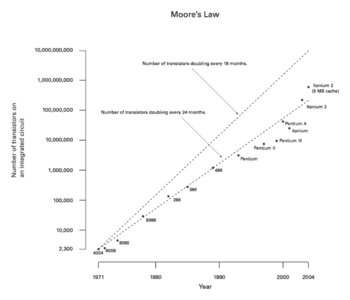
Intel was founded on July 18, 1968 with one main goal in mind: to make semiconductor memory more practicle. Intels first microprocessor, the 4004 microcomputer, was released at the end of 1971. The chip was smaller then a thumbnail, contained 2300 transistors, and was capable of executing 60,000 operations in one second. Shortly after the release of th 4004 the 8008 microcomputer was released and was capable of executing twice as many operations per second then the 4004. Intels commitment to the microprocessor led to IBM's choice of Intel's 8088 chip for the CPU of the its first PC. In 1982, Intel introduced the first 286 chip, it contained 134,000 transistors and provided around three times the performance of the other microprocessors at the time. In 1989 the 486 processor was released that contained 1.2 million transistors and the first built in math coprocessor. The chip was approximately 50 times faster then Intels original 4004 processor and equaled the performance of a powerful mainframe computer. In 1993 Intel introduced the Pentium processor, which was five times as fast as the 486, it contained 3.1 million transistors, and was capable of 90 million instructions per second (MIPS). In 1995 Intel introduced its new technology, MMX, MMX was designed to enhance the computers multimedia performance. Throughout the years that followed Intel released several lines of processors including the Celeron, the P2, P3, and P4. Intel processors now reach speeds upwards of 2200 MHZ or 2.2 GHZ.
Amdahl's law
From Wikipedia, the free encyclopedia

Amdahl's law, named after computer architect Gene Amdahl, is used to find the maximum expected improvement to an overall system when only part of the system is improved. It is often used in parallel computing to predict the theoretical maximum speedup using multiple processors.
The generalized Amdahl's law is:
where:
 is a percentage of the instructions that can be improved (or slowed),
is a percentage of the instructions that can be improved (or slowed), is the speed-up multiplier (where 1 is no speed-up and no slowing),
is the speed-up multiplier (where 1 is no speed-up and no slowing), represents a label for each different percentage and speed-up, and
represents a label for each different percentage and speed-up, and is the number of different speed-up/slow-downs resulting from the system change.
is the number of different speed-up/slow-downs resulting from the system change.
Moore's Law

Moore's Law is the empirical observation made in 1965 that the number of transistors on an integrated circuit for minimum component cost doubles every 24 months.It is attributed to Gordon E. Moore (born 1929), a co-founder of Intel. Although it is sometimes quoted as every 18 months, Intel's official Moore's Law page, as well as an interview with Gordon Moore himself, state that it is every two years.
Founders of Intel
Gordon E. MooreChairman Emeritus of the boardGordon E. Moore is the retired chairman and CEO of Intel Corporation. Moore co-founded Intel in 1968, serving initially as executive vice president. He became president and CEO in 1975 and held that post until elected chairman and CEO in 1979. He remained CEO until 1987 and was named chairman emeritus in 1997. Moore is widely known for "Moore's Law," in which in 1965 he predicted that the number of components the industry would be able to place on a computer chip would double every year. In 1975, he updated his prediction to once every two years. It has become the guiding principle for the semiconductor industry to deliver ever-more-powerful chips while decreasing the cost of electronics. Moore earned a bachelor's in chemistry from the University of California at Berkeley in 1950 and a Ph.D. in chemistry and physics from the California Institute of Technology in 1954. He was born in San Francisco on Jan. 3, 1929. He is a director of Gilead Sciences Inc., a member of the National Academy of Engineering, and a Fellow of the Royal Society of Engineers. Moore also serves on the board of trustees of the California Institute of Technology. He received the National Medal of Technology in 1990 and the Medal of Freedom, the nation’s highest civilian honor, from George W. Bush in 2002. |
1. Michael Angelo L. Orsonal
2. Rojie Urbane Alpas
3. May Ann Palomo
4. Jessa Mae Ulep
5. Rosella Amores
6. Johnwell Mahipus




No comments:
Post a Comment